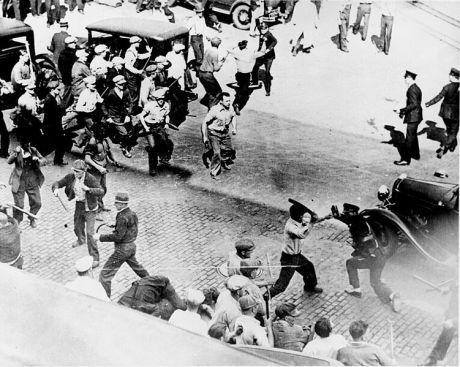Features
You are here
The Toledo Auto-Lite strike of 1934

October 5, 2012
The Toledo Auto-Lite strike is a valuable piece of working-class history. Workers, the unemployed and the Toledo community united to take on Electric Auto-Lite for better pay and conditions during the Great Depression.
By 1934, the people of Toledo were financially ravaged by the Great Depression. The largest employer had gone bankrupt and the city’s banks and finance companies had all but collapsed. Unemployment had skyrocketed to a startling rate of 70 per cent.
It is against this backdrop that the Electric Auto-Lite factory workers (who made parts, equipment, and accessories used in the manufacturing of automobiles), began a strike on February 23 in an attempt to win a 10 per cent wage increase, along with improved working conditions and an end to discrimination towards union members. Five days after the strike began, management and the Federal Labour Union 18384 (who represented the Auto-Lite workers along with a variety of other industries in Toledo) agreed to a 5 per cent wage increase and to further negotiate a contract. Several days later though, management refused to sign the new contract and broke off negotiations. Days later, the FLU organized a second strike, but this time only a quarter of the workers walked out.
Despite vocal support from the largest unions in Toledo, the strike began to collapse. The American Workers’ Party, represented in the area by the Lucas County Unemployment League (LCUL), and led by radicalized labour leaders Ted Selander and Sam Pollock, entered on the workers’ behalf to help with organizing the strikers. This was the beginning of an upswing in worker militancy that to this day has been a shining light for the labour movement.
The strike
The LCUL’s first step was to encircle the factory with striking workers, who were further joined by droves of unemployed workers.
The Electric Auto Co., feeling the heat coming from a mobilized force of picketers, was able to acquire a court injunction limiting the number of pickets to 25 at each exit of the plant. The picketers were instructed by the LCUL to defy the injunction, despite the possibility of arrest.
As the strike resumed, only four picketed, two of which were LCUL leaders Ted Selendar and Sam Pollock, who were subsequently arrested. The two were released the next day with suspended sentences and arrived back on the picket line several hours later, pleasantly surprised to see picketer numbers having grown to 40.
On May 11, Selender and Pollock, along with their fellow picketers, were arrested. A show trial was attempted by the county, but through a steady showing of support by members of the community and picketers, who packed the courtroom and disrupted the trial at any chance, the entire group of arrested picketers was released without charge. Between 30 and 60 picketers a day continued to make their presence known outside the Auto-Lite plant during each day of the trial.
The Auto-Lite company, seeing the trial as the perfect distraction, hired 1,500 strikebreakers to re-open the plant and continue production. In addition, they hired armed guards and purchased $11,000 of tear and vomit gas. The LCUL responded by turning all their attention to the mass picketing of the plant. By May 21, speeches were being given to over a thousand picketers. By the next day, 4,000 had gathered.
The battle
On the afternoon of May 23, anger finally boiled over. In front of a crowd of over 10,000 picketers, Louis Budenz (executive-secretary of the American Workers’ Party) and four others were arrested. The last straw was when guards tried to disperse the crowd with a fire hose, and attempted to escort shift-changing strikebreakers into the factory.
The crowd began throwing bricks and stones, and the fire hose was seized and turned on the guards and county deputies. The tear and vomit gas thrown by the guards on the plants roof was thrown back just as quickly. The riot got so fierce and unrelenting that the scabbing workers and guards hid in the dark until early morning the next day, when 900 National Guardsmen showed up.
Later that afternoon, a crowd of over 6,000 continued to congregate. By night, the crowd had begun rioting again. National Guardsmen charged with bayonets, and proving ineffective, began firing into the air and then into the crowd. Two were shot dead, while at least 15 others received injuries. The crowd continued to fight forward despite the shooting and forced the Guardsmen back into the plant.
The next day, May 25, the plant was closed indefinitely by Auto-Lite officials in an attempt to curb further violence. By May 31, the National Guardsmen were withdrawn.
Aftermath
Tensions were high across Toledo over the treatment of the striking workers. With talk of a mass general strike in the air, workers and unions across the Solar Valley where able to make great gains via tentative agreements (some affiliates gaining up to as much as a 20 per cent wage increases). The FLU 18384, on June 2, reached an agreement with Auto-Lite management, gaining a 5 per cent wage increase and a guaranteed minimum wage of 35 cents. Upon worker ratification, picketing of the Auto-Lite plant ended for the first time since February 23. On June 9, a victory parade took place in which some 20,000 people marched.
The Auto-Lite fight was one of the most important labour fights in 20th-century America. It showed to all that independent solidarity between all workers—employed or unemployed—and across different sectors of work is necessary to make gains in a period of economic crisis. These lessons hold true today, as the working class has got to link their fights—public and private, unionized and non-unionized, service users and service providers—to beat back austerity.
Section:
Topics:
- Log in to post comments










